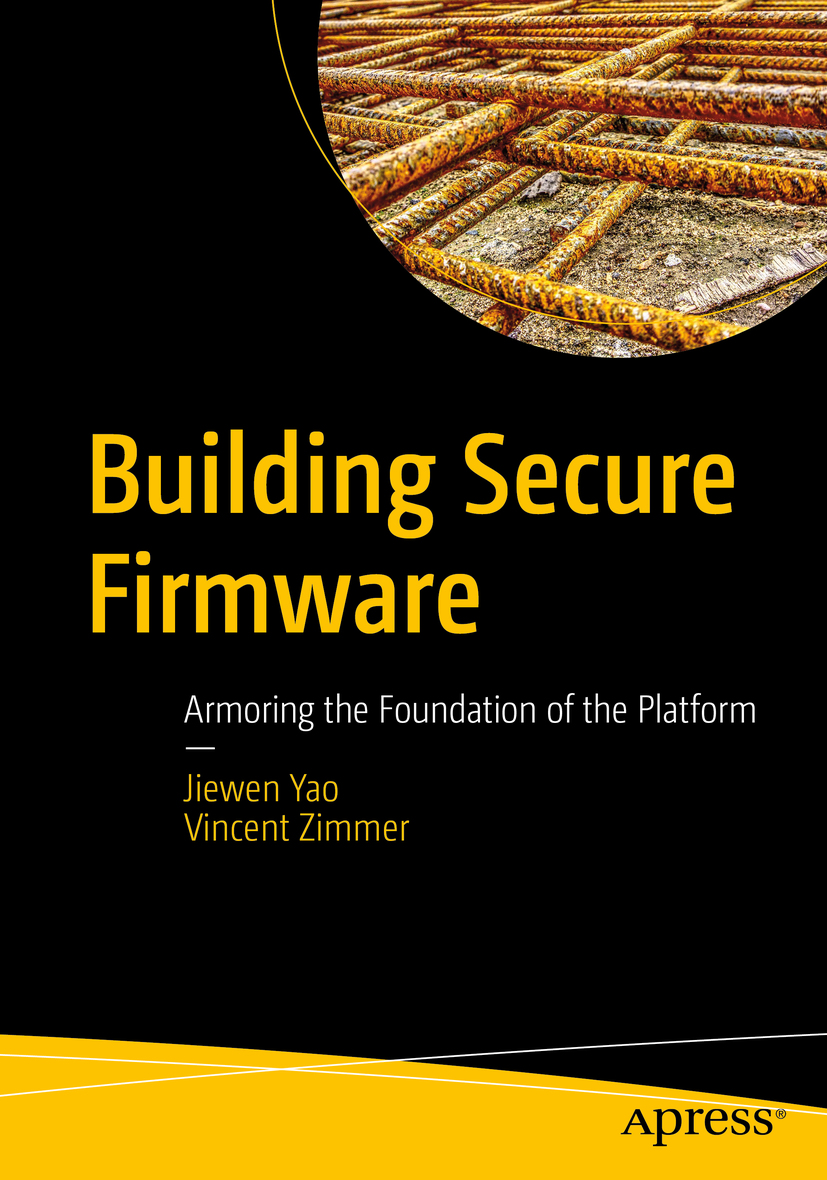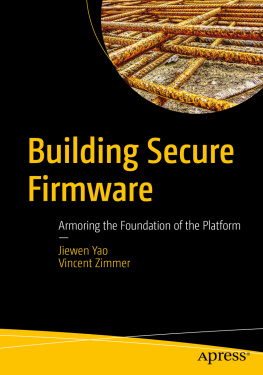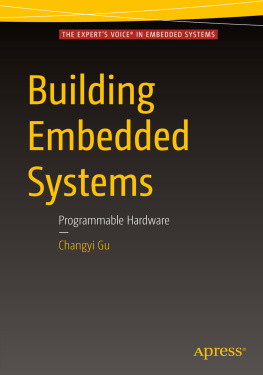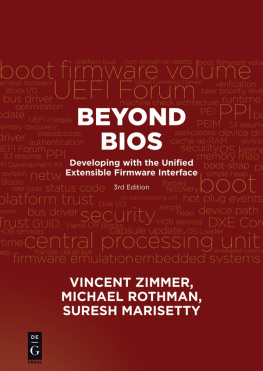Jiewen Yao - Building Secure Firmware : Armoring the Foundation of the Platform
Here you can read online Jiewen Yao - Building Secure Firmware : Armoring the Foundation of the Platform full text of the book (entire story) in english for free. Download pdf and epub, get meaning, cover and reviews about this ebook. year: 2020, publisher: Apress, genre: Computer. Description of the work, (preface) as well as reviews are available. Best literature library LitArk.com created for fans of good reading and offers a wide selection of genres:
Romance novel
Science fiction
Adventure
Detective
Science
History
Home and family
Prose
Art
Politics
Computer
Non-fiction
Religion
Business
Children
Humor
Choose a favorite category and find really read worthwhile books. Enjoy immersion in the world of imagination, feel the emotions of the characters or learn something new for yourself, make an fascinating discovery.
- Book:Building Secure Firmware : Armoring the Foundation of the Platform
- Author:
- Publisher:Apress
- Genre:
- Year:2020
- Rating:5 / 5
- Favourites:Add to favourites
- Your mark:
- 100
- 1
- 2
- 3
- 4
- 5
Building Secure Firmware : Armoring the Foundation of the Platform: summary, description and annotation
We offer to read an annotation, description, summary or preface (depends on what the author of the book "Building Secure Firmware : Armoring the Foundation of the Platform" wrote himself). If you haven't found the necessary information about the book — write in the comments, we will try to find it.
Jiewen Yao: author's other books
Who wrote Building Secure Firmware : Armoring the Foundation of the Platform? Find out the surname, the name of the author of the book and a list of all author's works by series.
Building Secure Firmware : Armoring the Foundation of the Platform — read online for free the complete book (whole text) full work
Below is the text of the book, divided by pages. System saving the place of the last page read, allows you to conveniently read the book "Building Secure Firmware : Armoring the Foundation of the Platform" online for free, without having to search again every time where you left off. Put a bookmark, and you can go to the page where you finished reading at any time.
Font size:
Interval:
Bookmark:


Any source code or other supplementary material referenced by the author in this book is available to readers on GitHub via the books product page, located at www.apress.com/978-1-4842-6105-7 . For more detailed information, please visit http://www.apress.com/source-code .
To my lovely wife, Wenjun Zeng. Thank you for your constant encouragement and unconditional support!
Jiewen Yao
To my parents; to my wife, Jan; and to my daughters, Ally and Zoe. Your support and love are rays of sunshine that warm my days.
Vincent Zimmer
When Saudi Aramco was attacked in August 2012 by the Shamoon computer virus, it was a wake-up call to the entire industry. Saudi Aramco is one of the largest companies in the world and holds the second largest amount of crude oil reserves. A shutdown of Saudi Aramco for a prolonged amount of time would have had a devastating impact on the oil economy, and this could have plunged the world into an economic recession.
The Shamoon virus was by todays standards a relatively simple virus. It overwrote the master boot record on the hard disk with garbage, rendering the system unbootable. While the infestation was effective reportedly more than 30,000 systems got impacted the much-feared secondary effect of the global oil supply chain hiccup didnt materialize. That was in part because the hard disk is an easy to service component and Aramco was able to replace the hard disks in time to avoid any serious impact.
However, this attack made folks in the industry and intelligence communities around the world wonder: What would have happened if Shamoon went after a non-serviceable component, like the flash chips where the system firmware is stored? This is much harder to repair on-site, and it would have required the systems to be shipped back to the manufacturer. This would have taken a lot more time, and in that case a global oil supply shortage could not have been avoided, potentially even triggering a global recession.
BIOS update authentication: The firmware needs to be signed by the proper authority.
Integrity protection: The firmware cannot be modified, either unintended or maliciously.
Non-bypassibility: There is no way to bypass the authenticated firmware update mechanism.
This specification was followed up in 2018 by another NIST publication, Platform Firmware Resiliency Guidelines (NIST SP800-193). This specification extended the previous one by focusing on recovery. Its central tenet was simple: providing protection against unauthorized firmware updates is not enough. The firmware is a complex piece of software, and it will, probabilistically, contain bugs that can be exploited by an attacker. How do you quickly and seamlessly recover if this happens?
Before you consider this problem to be a PC-only threat, think again. With the proliferation of IoT devices in homes and factories, and SCADA devices to control the national grid, firmware security has become a key part of the worlds critical infrastructure protection. Just imagine the harm a malicious attacker could do by taking over the firmware of pipeline controllers in a gas line in Siberia, Russia, during the winter. Youll be hard-pressed to send someone out there to fix the problem.
The Saudi Aramco attack and its resulting NIST secure firmware recommendations solidified the importance of firmware security in the industry. Those recommendations built on years of academic and industrial research in this area. I was personally involved in some of these efforts, ranging from IBMs physical secure coprocessor (IBM 47xx) projects and TCPA/TCG frameworks to secure hypervisor research and working with other industry partners on the foundations of NIST SP800-147.
The authors Jiewen Yao and Vincent Zimmer have bundled together into this book their combined years of experience in developing secure firmware and building resilient systems. Every computer, big or small, starts with firmware, and if thats compromised, all is lost, so following the authors guidance is as relevant today as it was in 2012.
Leendert van Doorn
Redmond, WA, USA
Currently, we already have books to separately introduce the topics of firmware and security. The purpose of this book is to link these areas together and provide the best practices in the security development of firmware.
The whole book consists of four parts:
Part I: Overview
Chapter includes a brief overview of the firmware in a system.
Chapter describes a proactive development lifecycle for the firmware. We will introduce a general threat model for the firmware and use a real example to demonstrate how to do threat model analysis.
Part II: Security Architecture
Chapter describes the first aspect of the firmware resiliency protection.
Chapter describes the second aspect of the firmware resiliency detection.
Font size:
Interval:
Bookmark:
Similar books «Building Secure Firmware : Armoring the Foundation of the Platform»
Look at similar books to Building Secure Firmware : Armoring the Foundation of the Platform. We have selected literature similar in name and meaning in the hope of providing readers with more options to find new, interesting, not yet read works.
Discussion, reviews of the book Building Secure Firmware : Armoring the Foundation of the Platform and just readers' own opinions. Leave your comments, write what you think about the work, its meaning or the main characters. Specify what exactly you liked and what you didn't like, and why you think so.











